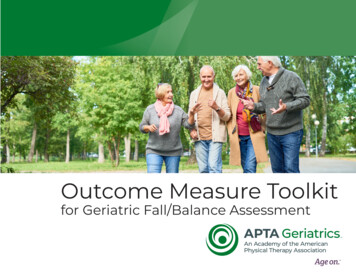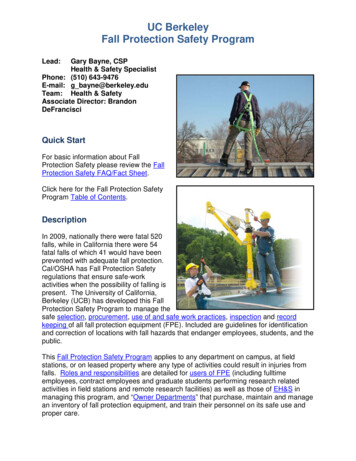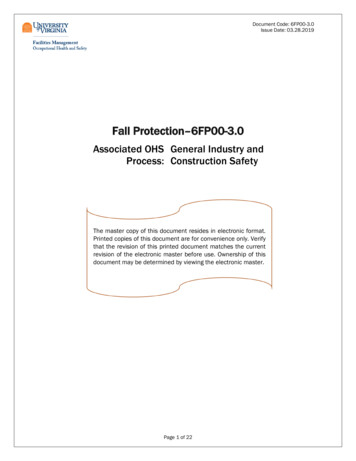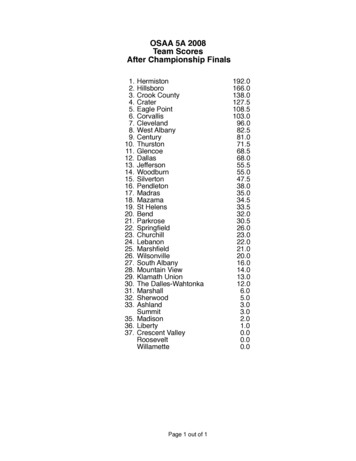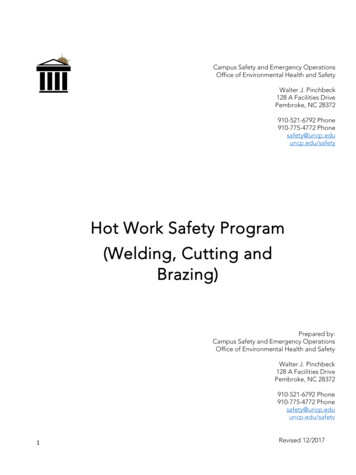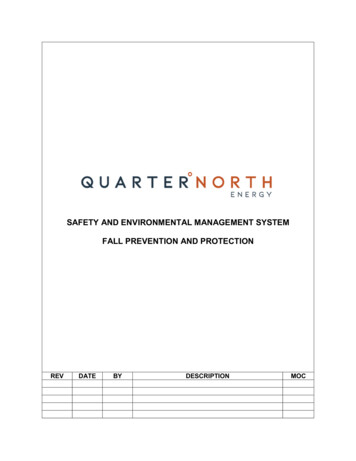
Transcription
SAFETY AND ENVIRONMENTAL MANAGEMENT SYSTEMFALL PREVENTION AND PROTECTIONREVDATEBYDESCRIPTIONMOC
Fall Prevention and ProtectionSection ChapterD6Rev. 0Page 2 of 15TABLE OF CONTENTS1.PURPOSE . 32.SCOPE . 33.REFERENCES . 44.DEFINITIONS . 55.ROLES AND RESPONSIBILITIES . 66.5.1.Person in Charge or Project Supervisor . 65.2.Workers . 7REQUIREMENTS . 76.1.Methods of Fall Prevention . 76.2.Hazard Control Hierarchy (Hazards Analysis) . 76.3.Fall Protection Requirements by Situation . 76.4.Fall Protection Systems . 86.4.1.Self-Retracting Lanyard (SRL) . 96.4.2.Fall Rescue Equipment . 96.4.3.Horizontal Lifeline. 96.4.4.Vertical Lifeline .106.5.Anchor Point .106.6.Inspection.106.7.Cleaning .106.8.Removal from Service .116.9.Storage .116.10. Accessing the Work Area at Height.116.11. Unplanned Open Hole Reporting.126.12. Hole Covers.126.13. Open Hole Attendant .126.14. Handrails/Guardrails of Deck Openings .136.15. Potential to Fall to the Water.146.16. Fall Rescue Plan/Checklist .147.TRAINING .15
Fall Prevention and Protection1.Section ChapterD6Rev. 0Page 3 of 15PURPOSEThe purpose of this procedure is to describe the policy, guidelines, and regulatoryrequirements that shall be followed to mitigate the risks associated with personnel workingat heights on all QuarterNorth Energy (QNE) owned or operated facilities. Specifications forfall protection equipment construction, inspection and use will also be outlined.2.SCOPE1.2.3.4.5.The following requirements/practices are detailed in this procedure:Job planningRescueSecuring Openings of Elevated Decks and Open HolesBarriers and BarricadingFall prevention techniques using the following are detailed in this procedure:1.2.3.4.Fall protection systemsLaddersScaffoldsDeckingThis procedure applies to all QNE employees and contractors including shelf, deep water,drilling, workover, completions, plug and abandonment, and construction activities on QNElocations.In addition to employee requirements, contractors working on QNE locations will:1. Comply with the procedure, however where there is a conflict with the procedurerequirements noted herein and a contractor’s safety program, workers will comply withthe stricter of the two.2. Ensure that equipment used meets or exceeds applicable regulations, standards, andguidelines.3. Ensure that their employees are adequately trained in the use, inspection, andmaintenance of all fall protection equipment4. Have a written rescue plan in place, communicated and have available all equipment toexecute a prompt, safe rescue/retrieval of personnel in a timely manner prior to startingwork.
Fall Prevention and Protection3.Section ChapterD6Rev. 0Page 4 of 15REFERENCESThis table represents references consulted in development of this safe work 10.11Personnel and Debris NetsA10.22Safety Requirements for Rope-Guided and Non-guided Workers' Hoistsfor Construction and Demolition OperationsA14.3Fixed LaddersZ359Fall Arrest SystemsA14.1,A14.2,and A14.5Safety Requirements for Portable Wood, Metal, and ReinforcedPlastic Portable LaddersA92.2Vehicle-Mounted Elevating and Rotating Aerial DevicesA92.3American National Standard for Manually Propelled Elevating AerialPlatformsA92.5American National Standard Boom-Supported Elevating Work PlatformsA92.6Self-Propelled Elevating Work PlatformsB30.23Personnel Lifting SystemsB30.9SlingsAPI RP 2D (5.2.4b)Offshore CranesUSCGPart 142,(OCS Facilities)33 CFRSubchapter NSubpart B – Personal Protective Equipment, 142.42Safety Belts and Life LinesSubpart C – General Workplace Conditions, 142.87Guarding of Deck OpeningsPart 143,(OCS Facilities)OSHAEquipment and Design, Subpart B, OCS Facilities143.110 Guards and Rails3146Fall Protection in Construction29 CFR1910.21–23 General Industry1910.28 Safety Requirements for Scaffolding1915 Maritime Industry1917.119 Portable Ladders1926.106 Working over or near Water1926.450 Subpart L Scaffolds1926.451 General Requirements1926.500 Subpart M Construction Industry, Fall Protection1926.1431 Hoisting Personnel1926.1501 (g) Crane or derrick suspended personnel platformsBSEE30 CFR 250Oil and Gas and Sulfur Operations in the Outer Continental Shelf
Fall Prevention and Protection4.Section ChapterD6Rev. 0Page 5 of 15DEFINITIONSAnchorage - A secure point of attachment for lifelines, lanyards, or deceleration devices.Body Harness - Straps which may be secured about the employee in a manner that willdistribute the fall arrest forces over at least the thighs, pelvis, waist, chest, and shoulderswith means for attaching it to other components of a personal fall arrest system.Competent Person - A person capable of identifying and correcting predictable fall hazardsin their work environment. A competent person for this procedure will be trained andexperienced in fall hazards, fall rescue equipment and procedures.Controlled Access Zones - An area in which certain work may take place without the use ofguardrail systems, personal fall arrest systems, and where access to the zone is controlled.Deceleration Device - Any mechanism, such as a rope grab, rip stitch lanyard, speciallywoven lanyard, tearing or deforming lanyards, automatic self-retracting lifelines/lanyards,etc., which serves to dissipate a substantial amount of energy during a fall or otherwise limitthe energy imposed on an employee during fall arrest.Deceleration Distance - The additional vertical distance a falling victim travels, excludinglifeline elongation and free fall distance, before stopping, from the point at which thedeceleration device begins to operate. It is measured as the distance between the locationof an employee’s body harness attachment point at the moment of activation (at the onset offall arrest forces) of the deceleration device during a fall, and the location of that attachmentpoint after the employee comes to a full stop.Free Fall - The act of falling before a personal fall arrest system begins to arrest the fall.Free Fall Distance - The vertical displacement of the fall arrest attachment point on theemployee’s body harness between onset of the fall and just before the system begins toapply force to arrest the fall. This distance excludes deceleration distance, and lifeline /lanyard elongation, but includes any deceleration device slide distance or self-retractinglifeline / lanyard extension before they operate and fall arrest forces occur.Guardrail System - A barrier erected to prevent employees from falling to lower levels.Lanyard - A flexible line of rope, wire rope, or straps which generally has a connector at eachend for connecting the body harness to a deceleration device, lifeline, or anchorage.Leading Edge - The edge of a floor, roof, or formwork for a floor or other walking / workingsurface (such as the deck), which changes location as additional floor, roof, decking, orformwork sections are placed, formed, or constructed to be an “unprotected side and edge”during periods when it is not actively and continuously under construction.Lifeline - A component consisting of a flexible line for connection to an anchorage at one endto hang vertically (vertical lifeline), or for connection to anchorages at both ends to stretchhorizontally (horizontal lifeline), and which serves as a means for connecting othercomponents of a personal fall arrest system to the anchorage.Open Hole - A hole that is 2 inches or more at its greatest distance, located in any walkingor working surface.Personal Fall Arrest System - A system used to arrest an employee in a fall from a workinglevel. It consists of an anchorage, connectors, a body harness, and may include a lanyard,deceleration device, lifeline, or suitable combinations of these.
Fall Prevention and ProtectionSection ChapterD6Rev. 0Page 6 of 15Rope Grab - A deceleration device that travels on a lifeline and automatically by friction,engages the lifeline and locks so as to arrest the fall of an employee. A rope grab usuallyemploys the principle of inertial locking, cam/level locking, or both.Rescue Plan – A scenario-based plan of rescuing a potential fall victim including the means,methods, equipment, and resources necessary to execute a safe, prompt rescueSafety Monitoring - A safety system in which a competent person is responsible forrecognizing and warning employees of fall hazards.Self-Retracting Lifeline/Lanyard - A deceleration device containing a drum-wound line, whichcan be slowly extracted from or retracted onto the drum under slight tension during normalemployee movement, and which after onset of a fall, automatically locks the drum and arreststhe fall.Standard Railing (Handrail) - Shall consist of a top rail, intermediate rail, and posts, and shallhave a vertical height of 42 inches nominal from upper surface of top rail to floor, platform,runway, or ramp level and shall meet OSHA 29 CFR 1910.23 requirements.Standard Stair Railing (Handrail) - Shall be of construction similar to a standard railing butthe vertical height shall be not more than 34 inches nor less than 30 inches from the uppersurface of top rail to surface of tread in line with face of riser at forward edge of tread andshall meet OSHA 29 CFR 1910.23 requirements.Twin Lanyard - Two lanyards sharing a common shock absorbing device.Unprotected Sides and Edges - Any side or edge, 4 feet or more above adjacent floor orground level, (except at entrances to points of access) e.g., floor, roof, ramp, or runway,where there is no wall or standard rail system at least 42 inches high.Walking / Working Surface - Any surface, whether horizontal or vertical, on which anemployee walks or works, including, but not limited to, floors, roofs, ramps, bridges, runways,formwork, and concrete reinforcing steel, but not including ladders, vehicles, or trailers, onwhich employees must be located in order to perform their job duties.5.ROLES AND RESPONSIBILITIES5.1.Person in Charge or Project Supervisor1. Understanding and complying with this procedure.2. Evaluating the potential elevated work hazards at the facility and verifyingsafeguards are in place according to this safe work practice and relevant permits.3. Ensuring that personnel assigned to work at heights and/or in proximity to an openhole requiring fall protection are involved in the job safety analysis process.4. Re-evaluating the potential elevated work hazards when changes in work areasmay affect the safeguards required.5. Monitoring work areas for compliance with this procedure and required safeguards.6. Evaluating the rescue plan7. Ensuring inspections are performed on the equipment8. Ensuring the Working from Heights and/or Open Hole Permit is completed prior tobeginning work from heights or opening of hole(s).
Fall Prevention and Protection5.2.Section ChapterD6Rev. 0Page 7 of 15Workers1. Understanding and following the requirements of this safe work practice2. Immediately reporting of potential fall hazards to their supervisors3. Bringing any questions or concerns about the type of personal fall protectionequipment or system installation on any job to the attention of supervision.4. Inspecting the personal fall protection system anchor points, connecting means,lanyards, harnesses, etc. prior to use5. Reporting any fall to supervisors immediately6. Removing from service any equipment subjected to the forces of a fall or havebeen inspected and found to contain deficiencies or defective components.6.REQUIREMENTS6.1.Methods of Fall PreventionAll personnel must be able to recognize where fall hazards exist, which may includethe following:1.2.3.4.5.6.7.6.2.Uneven surfacesObstacles or clutterElevated work areasInadequate handrailsInadequate barricades around a deck opening or edgeImproper climbing equipmentFall protection equipment failuresHazard Control Hierarchy (Hazards Analysis)Order6.3.Method1Eliminate fall hazards (ex. reposition equipment and valves to lower levels2Use traditional fall prevention (ex. handrails and guardrails) on permanentplatforms3Work from temporary or moveable platforms that are properly secured4Use fall restraint systems (ex. barricades or restraint lines that preventpersonnel from reaching the fall hazard)5Use fall arrest systems, ladder climbing systems, or other systems designedto “catch” personnel when the possibility of a fall cannot be preventedFall Protection Requirements by SituationA fall arrest system is a system that will stop a worker’s fall before the worker contactsthe surface below. The following are situations where 100% continuous attachmentfall arrest systems are required:1. Working at or above 6' above a working surface not protected by handrails orguardrails (measured from the deck to where an individual is performing work)
Fall Prevention and ProtectionSection ChapterD6Rev. 0Page 8 of 152. Working near or above handrails or guardrails where the potential to fall from aheight greater than or equal to 6' of the working surfaces.3. Ascending or descending uncaged ladders to a height greater than or equal to 6’where the deck above does not contain adequate fall prevention (ex. no guardrails,handrails, or lift gate above)4. Ascending or descending uncaged ladders to a height at or above 20'5. Ascending or descending ladders with or without cages regardless of height, wherea risk assessment has determined that a fall protection system is required.6. Performing stationary maintenance on a ladder at or above 6' from the next levelwhile working equal distance as the height from a protected side or edge.7. Where exposure to an open hole exists8. Working over water or at the bottom level (ex. 10 deck) while performing worktasks such that creating an open hole is part of the work (ex. changing grating)9. Working from a lifted basket over a deck (ex. spider or approved work basket)10. Work on scaffolds, both suspended and erected. In certain instances, on erectedscaffolds inspected by competent person to be in compliance with all necessarysafeguards (ex. fully enclosed hand rails, mid-rails, access gate enclosure, toeboards, and no open holes as stated in definition above) the use of fall protectiononce in the confines of the erected scaffold may allow for removal of fall protectiondependent upon risk assessment. At no time will workers be allowed to remove fallprotection while working on a suspended scaffold.11. When working at a height greater than or equal to 6’ but less than 20’, use a selfretracting lanyard or lanyard of suitable length to prevent impact to object(s) below12. At no time will a worker be allowed to be left alone while working at heights wherefall protection is required.6.4.Fall Protection SystemsThe Lanyard is part of a fall arrest system when used with an approved shock absorberand attached to the fall arrest attachment of a full body harness and is designed toconnect a worker to an anchorage. Lanyards must be ANSI Z359.1 approved.Lanyards must have a shock absorbing device integral to them. Shock absorbers shallallow for a maximum deceleration distance of 3.5 feet, and limit fall arrest forces to900 lbs. All snap hooks integral to lanyards shall be of the self-locking/self-closingdesign. Lanyards shall be capable of supporting 5,000 lbs.1. Lanyards shall have self-closing, self-locking snap hooks and/or carabiners toreduce the possibility of rollout. Do not use snap hooks or connectors that will notcompletely close when attached.2. Connect the middle snap hook of the twin lanyard to the back D-ring of an approvedfull body harness. Connect the snap hook at the end of one leg to an initialanchorage. Connect the snap hook at the end of the other leg to a secondaryanchorage before moving and/or disconnecting from the initial anchorage.
Fall Prevention and Protection6.4.1.Section ChapterD6Rev. 0Page 9 of 15Self-Retracting Lanyard (SRL) SRL’s shall be installed using approved connectors (e.g., carabiners oranchor pads/straps), to an anchor point capable of supporting 5,000 lbs.The attachment point of the SRL shall be at the dorsal D-ring of theharness. Users of SRL’s shall not connect the snap hook of their lanyardto the snap hook of a SRL. SRL’s should be used when the potential freefall distance is greater than 6 feet, or when the height of thewalking/working surface is less than 12 feet from ground level.The Suspension Trauma Safety Step is suggested and designed to reducethe potential for suspension trauma following a fall in a full body harness.The loops of the safety step provide a means for the user to place load onthe legs while suspended in the harness.Full BodyHarnessTwin Leg ShockAbsorbingLanyard:Personal FallLimiter / SelfRetractingLanyard:SuspensionTrauma SafetyStrapAllows for 100% Tie Off6.4.2.Fall Rescue EquipmentWhere the requirement to use fall protection exists, so does the requirementto have adequate fall rescue equipment on site exists as well. This includesall equipment as specified within the required fall rescue plan including (butnot limited to) ladders, rescue poles, manual & auto decent devices, tripods,block and tackle devices, beam sliders/clamps designated for rescue, etc.6.4.3.Horizontal LifelineHorizontal lifelines shall be designed, installed, and used under thesupervision of a qualified person, as part of a complete personal fall arrestsystem, which maintains a safety factor of two. If the above criteria forhorizontal lifeline systems cannot be met, a pre-engineered and tested
Fall Prevention and ProtectionSection ChapterD6Rev. 0Page 10 of 15horizontal lifeline system shall be used in lieu of a make-shift horizontallifeline.6.4.4.Vertical LifelineWhen vertical lifelines are used, each employee shall be attached to aseparate lifeline. Components of the vertical lifeline system shall be capableof supporting 5,000 lbs. The attachment point of the fall arrestor shall be atthe dorsal D-ring of the harness. When permanently installed ladder climbingsystems are used, the fall arrestor shall be attached at the chest D-ring of theharness.6.5.Anchor PointAn anchor point is a secure point of attachment for lanyards, lifelines, or othercomponents of a personal fall arrest system. Anchor points shall be capable ofsupporting 5,000 lbs. per employee attached, or shall be designed with a safety factorof at least two by a qualified person.An anchor point should be as directly overhead as possible, or attachment to theanchor point should be chosen as to not allow a free fall of greater than 6 feet. Incases where the anchor point is lower than the attachment point of the harness, ashorter lanyard or other fall arrest device (i.e., retractable lifeline) should be used.Typical Choker Configuration6.6.InspectionPersonal fall arrest systems shall be inspected prior to each use. Check the fall-arrestforce indicator before use. All stitches through the fold must be intact. Inspect allwebbing (straps) and stitching for cuts, fraying, pulled/broken threads, abrasion,excessive wear, altered or missing straps, burns, UV damage, heat or chemicalexposures. Inspect all parts for deformation, cracks, corrosion, deep pitting, burrs,sharp edges, cuts, or nicks. Check for missing, loose, or improperly functioning parts.Inspect all labels to ensure they are legible.6.7.CleaningClean the harness and lanyard with a solution of water and mild detergent. Dryhardware with a clean cloth and hang to air dry. Do not use heat. Excessiveaccumulation of dirt, paint, or other foreign matter may prevent proper function of the
Fall Prevention and ProtectionSection ChapterD6Rev. 0Page 11 of 15harness and, in severe cases, weaken the webbing. To clean quick connect bucklesremove foreign material with a cotton swab. In dusty environments, fine particles canprevent proper function of the buckle. Dip the buckle in clean water to flush fineparticles. Remove excess water and allow to air dry.6.8.Removal from ServiceEquipment which is damaged or in need of maintenance must be tagged “UNUSABLE”and removed from service. Corrective maintenance and repair, such as replacementof elements, must be performed by the manufacturer. Do not attempt field repairs. Forharnesses that have quick connect buckles, a light penetrating oil can be applied tothe locking tabs to ensure smooth operation. Wipe any excess oil off with a clean rag.6.9.StorageStore the fall arrest system in a cool, dry and clean place out of direct sunlight. Avoidareas where heat, moisture, light, oil, and chemicals or their vapors or other degradingelements may be present. Equipment which is damaged or in need of maintenanceshould not be stored in the same area as usable equipment. Heavily soiled, wet, orotherwise contaminated equipment should be properly maintained (e.g. dried andcleaned) prior to storage. Prior to using equipment which has been stored for longperiods of time, an inspection is required. For harnesses with quick connect buckles,store the harness with the buckles connected.6.10. Accessing the Work Area at Height1. Prior to working at heights, all applicable job safety planning documents includingpermits, checklists, rescue plans, and job safety analysis will be conducted andapproved.2. Tools and other materials shall not be carried by hand while climbing a ladder. Formore information regarding ladder usage refer to (Section D, Chapter 13,Scaffolding and Ladders) in the Safe Work Practices section of the SEMS Portal.3. Special precautions shall be taken when wet or other slippery conditions exist.4. Vertical beams shall not be climbed.5. When using stairs, one hand shall be free to use the handrails.6. Climbing on equipment such as pumps, exchangers, valve hand wheels,transformers, electric motors, hand rails, structures, or any other facilities notdesigned for climbing should be avoided. Climbing on conduit, cable trays, or otherequipment not capable of supporting the weight of a person is prohibited.7. Adequate support should be available when walking in pipe bands to provide asafe walking/working surface without causing damage to piping, insulation, or heattracing.8. Personal fall protection must be used and anchored to a designated anchor pointwhen using, traveling on, or working from mobile work platforms such as: Spiders Man lifts Scaffolds
Fall Prevention and ProtectionSection ChapterD6Rev. 0Page 12 of 15 Scissor-lifts Man baskets6.11. Unplanned Open Hole ReportingWhen any open hole is found, personnel should immediately barricade the hole, if itis safe to do so.If the open hole affects any means of egress notify your immediate supervisor andCompliance Coordinator verbally and by email as soon as possible.Unplanned Open Hole Reporting Flow Chart6.12. Hole CoversCovers of sufficient structural integrity with a sure fit are the preferred method ofcorrecting open holes.The covers must be capable of supporting at least twice the weight of anticipated workload, materials or equipment that may be imposed on the cover at any one time.1. The cover should not protrude above the walking surface so as to cause a trippinghazard. Covers that protrude less than 1 inch above the plane of the walkingsurface and contain beveled edges are acceptable.2. The cover shall be secured to prevent accidental displacement by wind, equipmentor employees.3. The cover should be distinguishable by color coding (different color thansurroundings) or be labeled as “Hole” or “Cover”.6.13. Open Hole Attendant1. Prior to performing all work where planned open holes will be present, the OpenHole Attendant will ensure that the Working at Heights and/or Open Hole Permit isin place and approved.
Fall Prevention and ProtectionSection ChapterD6Rev. 0Page 13 of 152. Open holes lacking a cover or protective barrier shall be constantly attended to byan Open Hole Attendant (person with a specific duty to keep other workers fromaccessing the area. Also referred to as a “hole watch”).3. Open hole attendants must not be assigned additional duties and be present forall jobs involving open holes as there will be occasions where the hole will beunguarded by a cover or protective barrier (such as during cover removal orconstruction of barrier).4. An open hole attendant may be used in lieu of hard barricading only under thefollowing situations and after safety analysis and approvals (ex. JSA and open holepermit) have been performed:5. removing a hole cover and dropping a piece of equipment to a lower deck and thenimmediately replacing the cover6. The open hole attendant shall wear fall protection at all times, and any personnelworking within 6’ of the horizontal leading edge shall wear the same.The following are not adequate barriers for open hole protection:1. Cables without adequate anchoring or posting. Proper tensioning should not allowcables to be moved up or down more than six inches2. Light ropes, red danger or yellow caution tape, flagging tape (surveying tape), orsimilarly weak materials3. Wooden railings using less than 2” by 4” stock4. Construction fencing used without properly anchored or posted restraining cables6.14. Handrails/Guardrails of Deck OpeningsOpenings in decks accessible to personnel must be covered, guarded, or otherwisemade inaccessible when not in use. The manner of blockage shall prevent a person’sfoot or body from inadvertently passing through the opening.1. Every open-sided floor or platform 4 feet or more above adjacent floor or groundlevel shall be guarded by a standard railing on all open sides except where thereis entrance to a ramp, stairway or fixed ladder.2. The railing shall be provided with a toe board wherever, beneath the open sides;persons can pass, there is moving machinery or there is equipment with which fallmaterials could create a hazard.3. Every flight of stairs having 4 or more risers shall be equipped with stair railings.4. Any open hole that is created must be barricaded with hard pipe, cable orconstruction fencing in conjunction with cable to prevent personnel frominadvertently falling through.5. The top of the barricade must be at least 42” high and shall have a middle railing.6. Hard barricades must be able to withstand a load of at least 200 pounds appliedin any direction at any point of the rail.7. Shall have a 4” kick plate at the bottom if personnel are working below the opening(a standard handrail pipe can be used at the bottom as long as it is no more that4” from the top of the pipe to the decking).
Fall Prevention and ProtectionSection ChapterD6Rev. 0Page 14 of 158. Any open hole that cannot be barricaded immediately after exposure must bemonitored by an open hole attendant6.15. Potential to Fall to the WaterThe following are applicable when a fall hazard exists with the potential for a fall to thewater at all times and under all conditions:1. Use of fall protection and a USCG approved type I or V personal floatation deviceis required when outside a hand/guardrail system or near an unprotected leadingedge including ladder work.2. Communication must be maintained throughout the duration of the job andincluded in safety/rescue planning (Ex. Radio and Buddy System).3. Job safety planning, work authorization, and rescue planning are contingent uponidentifying risk factors such as winds, sea conditions including current, fog, or lowlight conditions.4. The job tasks below will require a designated stand-by vessel capable ofperforming rescue in the event of a fal
29 CFR . 1910.21- 23 General Industry : 1910.28 Safety Requirements for Scaffolding . 1915 Maritime Industry : 1917.119 Portable Ladders . 1926.106 Working over or near Water : 1926.450 Subpart L Scaffolds . 1926.451 General Requirements : 1926.500 Subpart M Construction Industry, Fall Protection . 1926.1431 Hoisting Personnel

